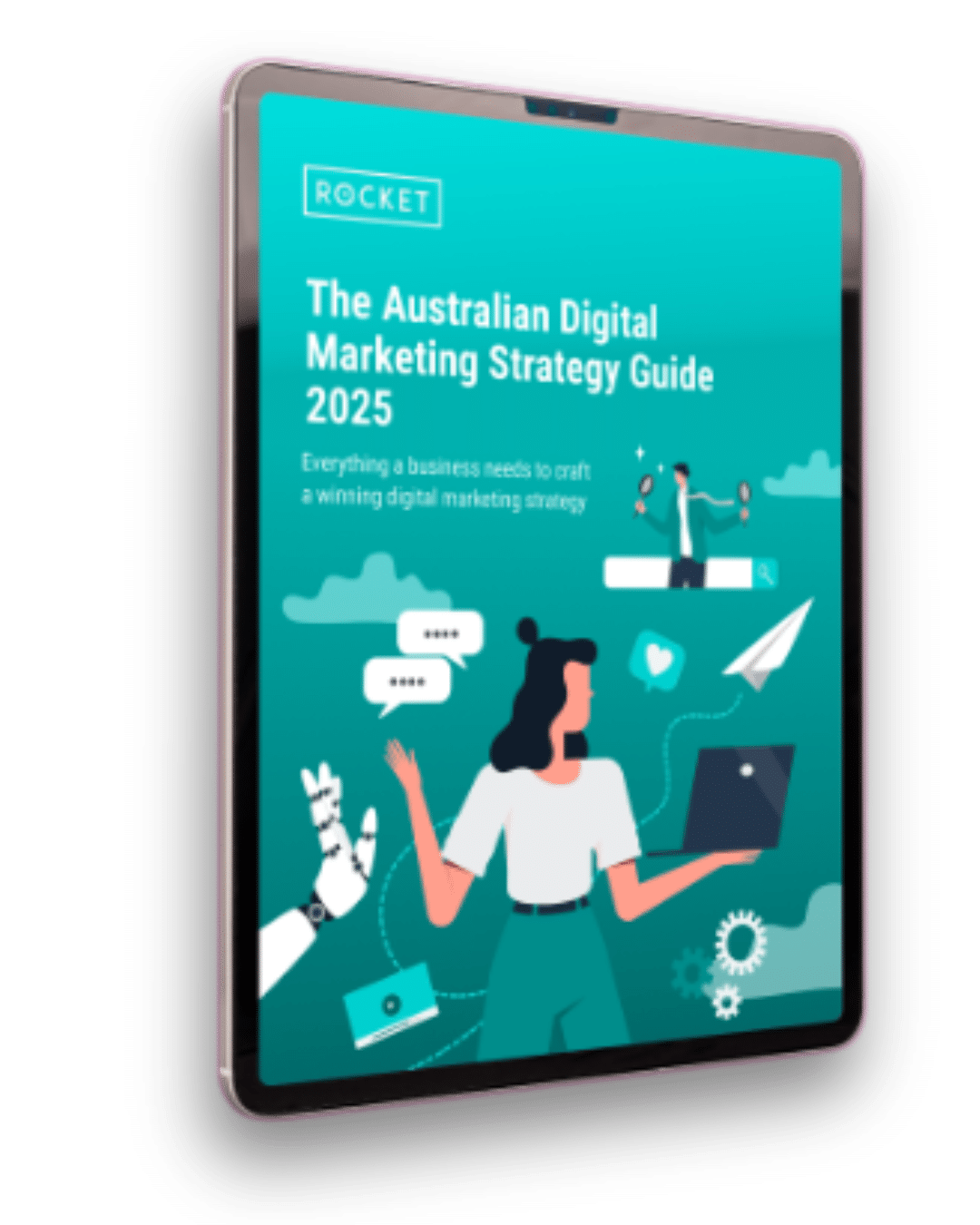What Percentage of My Company's Revenue Should Go Into Marketing?
Episode Description:
David Lawrence discusses how much of your company’s revenue should go into marketing. He shares industry-backed figures and practical tips to be able to present to your executive team.
Key Takeaways:
- Why a percentage rather than a dollar figure?
- Why does the size of marketing spend matter?
- When is a standard range not a good guide for your business?
- Good marketing is more important than a good product for a start-up company.
- What's a general rule of thumb when it comes to the percentage of revenue spent on marketing, and how does this differ for various industries?
- How to have a conversation with your boss about marketing spend.
Featuring:
About the Guest:
David Lawrence is the MD and Co-Founder of Rocket, an award-winning Australian digital marketing agency. He is also the co-author of the Amazon #1 best-selling marketing book 'Smarter Marketer'. David has presented at several events including Inbound Boston, Search Marketing Summit, Mumbrella360, CEO Institute and a variety of seminars and in-house sessions. Follow him on LinkedIn.
Transcript
James Lawrence: Today I am very happy to be joined by my much, much, much, much older brother David. On the back of the rampant success of our first pod together, we're going in for our second. Today, we want to dig into the topic of what percentage of a company's revenue should be spent on marketing, and trying not to come at it from a self-serving angle, where you spend as much as you can. But just a mature discussion about what we see our best clients doing, how to balance running a business versus running a marketing department, and what is an appropriate amount of money to spend on marketing today. Welcome back to the pod.
David Lawrence: It's good to be here again. Is it true that we broke the internet in our last episode?
James Lawrence: Yep. Mum and dad have been listening incessantly to our first pod. So I think first of all, we've both done some research coming into the pod, and we do have some numbers in these industries. A certain percentage are in B2B versus B2C, but I think the kind of most interesting thing to start off with is what expenses are we talking about when we talk about what percentage of your revenue should go into marketing? What would you say is reasonable there?
David Lawrence: I guess you're going to show your research in a second. But I was really blown away by your research. For me, it's pretty simple for our own marketing and think for the marketing quality of our clients, is that your marketing budget is the money you spend on headcount that's apportioned to the marketing effort of the business. Plus, of course, any money that you're spending on media and running campaigns, print material that's being used on the marketing side of the business. And of course, there's this gray area that makes it a bit hard. Some activities, sort of marketing, sort of sales, particularly if you're doing marketing or something like that, it can become quite gray. But for me, it's working out the absolute or the pro-rated people and expenses that are going towards marketing business.
James Lawrence: I think that's right. I think we one of the pieces that I was reading was looking through publicly available annual reports of big listed companies in the states, and they all account for things slightly differently. As you'd expect, a lot of them have amalgamated sales and marketing budgets. They have weird kind of line items around admin and administration, and kind of one of the stats that I thought was interesting was that less than half of the companies in this particular study included expenses for marketing employees and their marketing budgets. Often, companies would put marketing employee expenses into general and admin expenses, sales, other areas. So I think it is just important to make sure that you're putting in expenses that are generally marketing or get that depending on the structure and set up of particular businesses. It's going to be hard to totally get it right. But I think as long as we're talking from the same kind of baseline…
David Lawrence: It's kind of accounting trickery, isn't it? If you decided to employ a paid search specialist in house and as such, you weren't going to include them in your marketing budget, but had you made the decision to outsource that work to an agency, then it would be in your marketing budget. That doesn't make any sense.
James Lawrence: Yeah. That's it. I think it's the total cost of an employee, all expenses connected to that because it's the same. You're going to be paying on the other side. And that would make sense to me in terms of the topic itself, I think, why are we talking a percentage rather than an actual dollar figure when it comes to what percentage of your revenue should go into marketing?
David Lawrence: For me, marketing is it's very much the avenue, the engine that drives your future revenue, future sales, future leads as you become a larger organisation, the number of leads or sales or actual revenue that you need simply to grow. So if you were to do a set number, what worked for you as a $10 million business isn't going to work so well if you were a $100 million business, a percentage just makes it easier. It means it scales. And I think as the business does scale, you're going to find legends, right? You're going to find some bits where you haven't ramped up your head counting marketing or your agency environment. So probably your marketing spend as a percentage just drop a little bit. But I find typically companies feel that the amount of revenue they need simply can't be driven on the marketing engine they built themselves a year ago or two years ago or three years ago. So they have to ramp it up and sort of almost compensate for that change. But yeah, percentage makes sense because business sizes change.
James Lawrence: Yeah, totally. And if you're growing, it's just natural that that number moves. This might be an obvious question, but why does the size of marketing spend matter?
David Lawrence: So as a marketing spend, that is because it's going to influence the sort of company you have in the future. It’s a little bit of what I referred to before about it being the engine of your future revenue, but it gets even more subtle than that, where let's say you're under investing in marketing relative to your competition and for the business goals you have, then not only will you be introducing fewer people to your business, but the fact that you've introduced your people means that when your sales team go out to sell a product, if it's being sold in that way, or when your website's doing the work and selling your product or selling your service, you can be pretty price competitive. Because you have so few opportunities to make a sale. You've got to make everyone a winner.
David Lawrence: That has massive implications on a business. So if you decide to go down that path of not having many opportunities and you therefore have to price in a really competitive way, you're going to have a business that has relatively low margins and all the things that go along with that kind of business, whereas if you over generate your opportunities, this is whether you're a service business or product business, whether you B2B or B2C, it doesn't really matter. If you over generate opportunities, you get to specialise. You can say, well, we're only going to take on this particular criteria, or you're going to take on all kinds of work, but we're only going to take on work with the margins. So a company that's really comfortable and profitable, or you can aggressively go into spaces that are really hard, really competitive spaces you may not be in. If you can get your marketing engine really flying, you have a bit of a head start in some of those ultra competitive type areas. That's why what you actually invest in marketing matters. And anyone that's ever worked in a company that underinvested in marketing or did poor marketing knows what that feels like.
James Lawrence: That's it. I had a mutual friend of ours in the pod last week, Ashton, and he's one of the leading marketing strategists in Australia. And he was making that point that there is a very strong correlation between an overinvestment sensibly in marketing and margin, which is kind of the way you framed it - makes total sense. But it is an interesting connection, right? Invest in marketing aggressively compared to the competition and charge a price premium vs under invest. And you're kind of taking on everything you can possibly get.
David Lawrence: Often this conversation about marketing budget and percentage, it comes from 1 or 2 places. It comes from a marketer who wants to make sure that they're spending the right amount of money. Or typically, if you're the head of marketing, you want to probably spend a bit more money on marketing. So you're looking to see if your business is currently under investing as a percentage. And the C-suite tend to love a good number or percentage. And so it feels like a great way to pitch the request to increase investment. But it's also often happens the other way, which is you've got someone in the C-suite who's looking to save money. And the reality is that there are people that see marketing as an expense to be no different to cleaning or power or suppliers. And they want to cut it, particularly when times get tough. And so you do get that genuine tension between people that understand that the money they invest in quality marketing today, literally is the connection with the future comfort of their business, versus those that don't. So it's an interesting conversation that you get people looking for the percentage to argue it's too high or it's too low.
James Lawrence: And we did a lot of research when Covid hit and going back through tough economic trading periods, not just in Australia but America and Europe, going back to the 20s. And the objective research and the objective data showed the businesses that continued to invest in marketing when times were tough would come out a hell of a lot stronger than those that didn't. And we saw that. We saw that budgets in 2021, as a percentage of revenue dropped for marketing departments. And some of the data we’ll go through shortly. And I think we'll find once again that the businesses that stayed the course and were willing to invest in the future, they then come out of those periods much more strongly. And certainly businesses so impacted by Covid that it made no sense but to batten down the hatches. But for businesses that could keep trading, often cutting your marketing or halving it or whatever it might be is pretty shortsighted. What I wanted to discuss was, because we're going to jump into percentages on B2B versus B2C in different industries and big companies and small, but whether it's 5%, 10%, 20%, in a particular industry or segment, is a standard range not necessarily a good guide for a particular business.
David Lawrence: Yeah, that's a good question. A standard range is only a good guide. If you're a standard company and you've got standard competition and things have been pretty stable, there aren't too many areas of marketing and business where you can sort of color by numbers. So the standouts, though, are let's say you're a business that's in a highly competitive field. So let's say you're spending 10% on your marketing, but your competitors are spending 20%. Sadly, you don't really get to make that decision about 10% anymore. If you want to actually get your share of market, you're going to have to sell that, you know? So ignore the standards if your direct competitors are playing differently. If you're wanting to be a fast growth company, then you will have to spend more than you would be. It's pretty common sense, right? You have to spend more than you would if you were simply wanting to be business as usual for yourself. For that reason, we see startups always have to spend more than that in good marketing, sadly, is probably more important than good product when it comes to startup territory. There's so many books written on that very topic. You have to get the word out there and you have to get it out there, the right message. So if you're a startup, you've got to invest really heavily. Similarly, if you're a stable business but you're about to make a change in new products or services or you want to grow market share, you're going to have to spend more money. It's as simple as that to achieve those things. Otherwise you'll find that you take that pivot and nothing happens or things don’t happen as quickly as you want. So increasing your marketing spend kind of buys you into that future situation a whole bunch quicker.
James Lawrence: I kind of feel that we've seen that Silicon Valley kind of model where it is, don't worry about the revenue, worry about the growth and the users and whatever. And the idea that those businesses would be sticking to these types of percentages is just not reality. To your point, I think we're talking about businesses that are mature or in an industry that's kind of doing its thing and you're just kind of looking for steady growth, not revolutionary growth.
David Lawrence: Yeah, but the numbers we've got here are averages. So, you know, let's say there's an industry where the average is 12%. I guarantee you there's some companies spending a whole lot less than that. And I guarantee there's some companies spending a lot more than that. Yeah. And I guess the other factor that influences whether you're going to be in the range or not is the quality of your marketing. So if your marketing is poor 1s and yeah, you could be spending 2 or 3 times more than everyone else in the industry for the same or even worse results. So as always, marketing is highly competitive and challenging, and getting your marketing right is priceless when it comes to determining what percentage you're spending. And I think the I think the natural inclination, like a lot of the tension, I think that we say between marketing teams and, you know, CEO type level or board level is that they kind of want both. It's like 10% the the rule of thumb in a particular industry. So let's put 5% towards it. And you guys just do a 200% better job than the competition. And I don't think that's how it works. I think it's spend what you've got to spend and just do it really, really well to get you growth. Yeah. So for sure cool. Let's unpack the industries.
James Lawrence: Maybe we start talking just some stats that we found in reference to an article that will connect with the notes. I think the first is just across all businesses. What do we see generally, as a rule of thumb in terms of spend of revenue into marketing?
David Lawrence: As with all things, with The Economist, it's hard to get a consensus. But around that sort of 10 to 12 or 13% seems to be considered standard. So if that's the percentage of overall revenue spending on marketing, you're in that standard range.
James Lawrence: Yeah. So your $10 million business spending a million bucks a year on marketing…
David Lawrence: That's about 1-1.2% Yeah.
James Lawrence: Cool. And then generally speaking B2B versus B2C what are we seeing?
David Lawrence: So again, it's going to depend heavily on the type of business. There's also a distinction between whether it's a product business or a service business. So B2B product often is spending more around that sort of 10% mark. Whereas if we're looking at B2B service, these studies are showing that it's more around the 15% type mark. And similarly, if your B2C product, they came in highest in some of these surveys, above 18% of their spend, with B2C service was more around that 10% kind of mark. So interestingly, and you never know whether there's a variable because of the survey that's been done and who's been in it. But in the analysis that we saw, you're actually seeing B2B and B2C service were both around 10%. So B2B sort of a swap whether it was product or service. So it's a little bit of a difference there.
James Lawrence: I pulled some data which we’ll attach to the pod where, consumer packaged goods kind of much at the higher end of the scale, 24%, which kind of makes sense. Consumer services 15%, tax software 15%, they're kind of at the upper end. And then you look at the very bottom end; energy 4% manufacturing, 8%, transportation 8%. So I kind of feel that this data is useful for business owners, C-suite, useful for CMAs and marketing departments because it just adds some objectivity to it. Right? Are we in professional services? Are we in a kind of state segment that doesn't really need marketing? But it's pretty clear you're spending generally around ten and then you might be down to five, you might be up to twenty. And then there's some outliers either side. But if you're not in those ranges then you're probably under investing in marketing.
David Lawrence: Yeah that's it. And I think sometimes these big variations that you see in the ranges, a lot of it comes down to the audience that you're trying to market to. So if you've got a really large audience, you're gonna be spending a lot of money on awareness. And that can be, as we know, incredibly expensive and digital obviously can make that a bit more measurable and more effective, but it can still be quite effective. Whereas if you have a relatively small audience, then suddenly your sales team can often be quite heavily involved in that awareness piece, because you might only have a known market of 250 contacts. If you're dealing with enterprise corporations, you might not be doing any general large scale marketing at all and will be very, very sort of focused on the actual targets that you need to deal with.
James Lawrence: That's it. We pulled some numbers from some household names, and it's kind of fascinating. And these are sales and marketing budgets, so we probably don't have total clarity as to what sits where. Google is spending 12% in sales and marketing activity, Apple spending 6%, which is I think is kind of probably lower than I would have expected. One that's interesting, just fascinating, is Salesforce spending 46% of revenue goes into sales and marketing activity, and they're growing fast as well. Microsoft 16%. Oracle 22%. So you kind of see the tech businesses that need to get a message out. They're spending pretty heavily. Google, which probably hasn't done much above the line stuff until more recently, particularly in Australia, still spending 12%. Where the actual sales operations you think are pretty minor compared to the spend on marketing.
David Lawrence: It's they're really interesting numbers. I think you'd always have to question how these different corporations account for things and how transparent they are. But I suspect that churn is a really interesting thing here. So if you've got a company like Apple that's invested so heavily in their brand and in differentiating their products from the competitor's products, I think they retain their customers well, they charge a hefty premium on their products, and their marketing is to sort of enforce that brand. But they're not necessarily on a heavy customer acquisition kind of path in their marketing. Whereas Salesforce is operating in an incredibly competitive space with a number of CRM platforms that have come up in the last five years, is just staggering. I would imagine Salesforce have an incredible churn rate with their clients, and they're constantly trying to also, of course, take clients off their competitors. It must be an expensive space to be playing in the moment.
James Lawrence: And I guess you get scale, right? They've been around for a long time and they have the scale now where to add each user onto the platform doesn't have that incremental costs that it once would. The next area I wanted to dig into, just around increasing/decreasing marketing budgets; how can you do it easily, quickly short term versus long term? Your perspective on that?
David Lawrence: Yeah. So I guess there's some things that scale really nicely. So media spend tends to scale pretty nicely. You can put your assets together for your campaigns and scale up the amount of media you invest in. It can be quite effective depending on how you've structured things. People can be a whole lot harder. Obviously there's constant, and you've got episodes on this, there's a constant discussion between whether you want to in-house something or outsource things to an agency. If you're keeping positions in-house and trying to grow, that can be quite challenging, particularly in the current market where it's really tough to get your hands on good marketers, so agencies can provide an easy way to scale. So we certainly have clients who come onboard with us quite openly saying we intend to bring this in-house in the year or two years time, but we want to make sure we set it up properly and we get good eyes on it. And sometimes those relationships do go that way and they bring it back in-house. But quite often they really love that flexibility of being able to alter their spend in different quarters or different years, depending on what they need with us, without having to worry about the recruitment kind of headache. And other times it does go completely well. It sort of losses courses, but I think that's the plan. I think you've got to look at what you want marketing to achieve over a certain time frame, and then look at the levers you've got to play with, and some of those will go up and down very quickly. And some of them like you've got to really plan them.
James Lawrence: And if you're an in-house marketer listening to the pod, who feels that the marketing budgets you've been given just aren't enough based on the industry you're in, based on whether it's a fast growing business or it's in a space where businesses are spending 15% typically and you're only spending 5 or 10; any tips, tricks, insights into how you would try to mount those arguments internally to open up more budget?
David Lawrence: Yeah, absolutely. So if your competitors are public listed companies, you can get involved in the extraordinarily fun research, downloading annual reports, and they'll be publishing a fair bit of data that'll help you get a feel for it. Most people don't have that luxury. They're competing against privately held companies where that data is not available. But there's some great insight tools available. We use SEMrush for all of our campaigns. All our specialists are in SEMrush all the time, and they've got some tools that estimate the value of paid media campaigns. But they can also estimate the value of your campaigns and being run as well. There's other special specialist platforms that look into that now. They're all using external data sources that people aren't handing out on Facebook, aren't handing out their revenue details, but they're using amounts of traffic, that kind of stuff. So that can be a brilliant insight. You can also just get a feel by doing things like going into Facebook, if you're competing in that space and having a look at the ads that are being done by your competitors, and you'll start to get a feel for the complexity. And then, of course, once you visit sites, you'll be retargeting the market and you can see what people are doing. I think probably they're the main two things that jump to mind.
James Lawrence: I agree with both of those. I think LinkedIn's good. I think looking at your competition and looking at what sort of roles they have inside the business, are you looking at a marketing team of 10 or 15 staff and you're kind of at five trying to punch in company name and case study or marketing agency or SEO agency and looking if you can find examples so you can get a bit of a handle on what sort of agencies are they using or what sort of work are they doing? I think the data and sources that I found useful preparing for this; Gartner's done a lot of work in interviewing CMOs and marketers and looking at what percentage of marketing or what marketing budget is a percentage of total revenue. And I think trying to strip anything internal away from it and just saying objectively to your board or to the person responsible for budgets, just so you know, that we're B2B and we're a product company and we're in tech, this is what the competition is typically spending. And this the items they're spending it on. And I think there's some really good Gartner research, the one that I referred to earlier, spend is typically jump 10, 11, 12, then drop back in 2021 just after Covid, which I thought was kind of interesting. And depending a lot of good industry stuff as well, breaks it into consumer, financial, healthcare, retail travel and media manufacturing. If you kind of want to just pull out broad buckets, the Gartner research is quite good. I think in terms of your article that you put together, that's on the Rocket website, the sources there, that was Deloitte, wasn't it?
David Lawrence: Yeah. Back to that, that point you mentioned before about what do you do for an in-house marketer and you feel you haven't got sufficient marketing budget to achieve the KPIs you've been set? The number one thing you should do is be ready to speak up. There's no point at all in waiting a year and missing the targets and then telling people you weren't given enough money. It can be easy in any role to feel like a bit of an order taker, and you really got to step out of that mindset and step into a business mindset where you may not win the discussion, but quality people appreciate the fact you've raised it. If you go to your boss and they may go to their boss with a really well-considered argument that shows the sort of research that you've suggested. And I think that LinkedIn suggestion is fantastic. If you're a team of five people doing marketing with some really skinny budgets to agencies and you've checked in LinkedIn and you know your competitors, but it's 20 people in house and you've found them as award-winning case studies and a whole bunch of agencies websites, the people that make the decisions in your company should be aware that they're not going to win the battle, and they should be aware of that as soon as possible. So they can they might make the decision to leave the spend where it is, but at least you told them the impact you think that's going to have.
James Lawrence: You're just creating a rod for your own back. If you're not a taker and you're given a budget of X and your gut says, I can't actually achieve what I need to with this budget, it's kind of your fault, really. I think it's if you go to the powers that be and explain that based on market research, based on objective data, it's an underinvestment in marketing to achieve the goals that need to be hit. It's then on that stakeholder to say, well, that's fine. But you know, let's see how we go. But if you take the budget and put your plan together and don't hit it, well, kind of you've bought into that yourself.
David Lawrence: Yeah. That's it. One of the Rocket values is do what's right. And there's an obvious part of that which is do the right thing by clients, be ethical. It's obviously really important, but it almost sort of goes without saying. But I think the part of that value that resonates with me is the second part of it, which is say, what's right. So once you've figured out what the right and the wrong thing is, you have a responsibility to your colleagues and your clients and the people around you that you'll have the courage to actually speak up and let people know. And it doesn't mean you're always going to get your way, but you can at least make sure that nothing's left unsaid.
James Lawrence: I couldn't couldn't agree more. So I think that's it's kind of a nice way to wrap it out in terms of always finish the pod with a with a question around, what bit of advice would you give to a marketer wanting to succeed and grow their career? I think maybe as it pertains to this topic, I think you answered that question last time, but what is that one piece of advice you'd give to a marketer that the amount of money they're being given in their marketing budget just isn't enough to compete in their segment?
David Lawrence: My advice would be on preparing for the discussions. That's a given. You've got to have a discussion. But my advice would be preparing for that discussion. So doing the research and getting people on site and knowing where you're coming from and knowing that it's not some massive empire building push, but you genuinely care about the future of the company. And if it's underfunded in marketing, there's a direct connection from that to being unable to hit the goal. So you're doing your research and your preparation and then speaking up.
James Lawrence: That's really good. And it's funny, I asked the question of every guest on the pod the first time they come on, and at least half of the responses have been, speak the same language, talk the same metrics as the business, not marketing. And I think it's just that you have as a marketer, if you want to succeed, you've got to connect marketing into the business and it's got to be revenue, right? How are we driving revenue? And it's a very mature conversation to have with the powers that be. If you do, it's your responsibility to speak up and don't do it based on a whim or based on what you think, but base it on actual macro data.
David Lawrence: Yeah, I couldn't agree more. Fantastic.
James Lawrence: Awesome. Well, Dave, thanks for coming on to the pod. We'll get you back again.
We wrote the best-selling marketing book, Smarter Marketer
Written by Rocket’s co-founders, David Lawrence and James Lawrence, Smarter Marketer claimed #1 Amazon best-seller status within 3 hours of launch!

The Australian
Digital Marketing Strategy Guide 2025
Everything an in-house marketer needs to craft a winning digital marketing strategy.










































